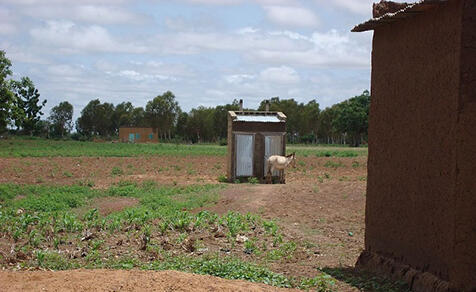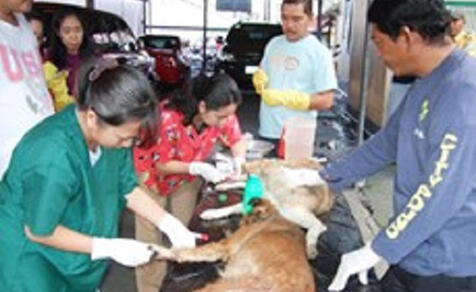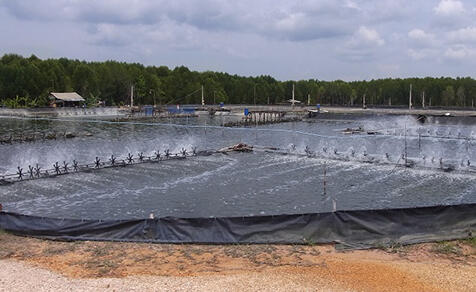Water conservation in the Nile basin- Saving water provides resources to turn desert into farmland -
Water conservation in the Nile basin
- Saving water provides resources to turn desert into farmland -
Research Fields and Areas
Environment/Energy (Global-scale environmental issues)

It almost never rains in Egypt, where approximately 95% of the land is desert. For that reason, almost all the drinking water and water required for farming comes from the Nile River. If you know that the Nile floods every year, you may think that the Egyptian people will have enough water as long as the Nile exists. However, the population of Egypt has been increasing very rapidly, so the demand for water is growing. In addition, before reaching Egypt, the Nile passes through many countries that have their own needs for water. For this reason, Egypt may suffer from a severe water shortage in the future. Egypt is trying to make effective use of the limited water resources available to continue providing its people with an enjoyable and prosperous life. This is the earnest hope of the people. The research conducted by this project had the aim of solving the country's water shortage problems, and studied efficient irrigation, appropriate crop cultivation for Egyptian conditions, and reuse of water. As a result, the way has been opened to reducing the amount of water required for agriculture by up to about 20% to 30%. By using the water obtained through water savings, larger areas of desert can be reclaimed as farmland, leading to the resolution of food problems. The day may not be far off when an expanse of land previously covered by sand will be securely transformed into fertile farmland.
* Irrigation: Introducing water into farmland for crop cultivation.

Principal investigator (Japan):Professor Emeritus SATOH Masayoshi
Faculty of Life and Environmental Sciences, University of Tsukuba
After receiving his Ph.D. in agriculture from the University of Tokyo, and serving as research assistant in the Faculty of Agriculture at Gifu University, and associate professor in the Faculty of Agriculture at Iwate University, he became associate professor at the University of Tsukuba in 1982, and then professor of irrigation in 1997. He has been professor emeritus at the University of Tsukuba since 2012.
He conducted a comprehensive study of the irrigation systems of Japan, examining both natural and social conditions. Since 1990, he has been involved in international activities on the development and management of water resources and irrigation.
 Japan perspective
Japan perspective
How to manage the Earth's water resources
We have only limited fresh water resources available for us on Earth. Due to population growth occurring mainly in developing countries, increasing demand for water is approaching the limit of water resource availability in many countries and regions. The problems emerge in different ways from region to region. Being one of the world's first countries to deal with this issue, Japan has grappled with the improvement of water management for more than 300 years, and also undergone serious urbanization in previously rural areas. Utilizing historical experience and the latest observation technologies, we gained a clear understanding of current water use system in the Delta, and proposed a basic direction for efficient and sustainable use of water resources. Most important of all is that the government, farmers and citizens share a common understanding on the reality of water to make transparent decisions. Researchers in this field are expected to make valuable contributions in this process.

Principal investigator (Egypt):Associate Professor Rushdi Mohammed Mohammed El-Kilani
Department of Soil Science, Faculty of Agriculture, Cairo University
After graduating from the Faculty of Agriculture, Cairo University (B.Sc. in Soil science), he obtained his M.Sc. (Water Management) and Ph. D. (Environmental Physics) from Wageningen Agricultural University, the Netherlands.
He has been working on environmental transport of heat and mass (water and pollutants) in ecosystems with the aim of optimizing their management regimes and reducing the effect of human activities on the ecosystems.
 Egypt's perspective
Egypt's perspective
Improving the water and soil management skills of Egyptian researchers
The success of the ancient Egyptians in establishing a great civilization was due to their success in understanding and coping very well with the hydrological and then agro-hydrological system of the River Nile. Nowadays, Egypt faces many challenges concerning the sustainable use of its water and soil resources. These challenges are represented by rapid population growth, together with rising expectations and demands on the resources, which exert big stresses on the ecosystem.
The dynamics of heat and mass exchange in the ecosystem is what controls the accumulation of certain substances in the environment and so, the long term sustainability of the system. The equipment and expertise provided by The WAT project to Egypt represents a very important step in the direction of understanding this exchange for the Egyptian Ecosystem. I would like to thank SATREPS, the Japanese researchers and the Japanese people for their help in this regard.
Project outcomes
Collected basic data necessary for achieving appropriate use of water
In order to make appropriate use of water in agriculture, we first need to know the water balance quantitatively: inflows such as irrigation and rainfall, and outflows such as evaporation, transpiration and percolation into the soil. This project was the first to precisely measure the water movement and estimate the water balance in the irrigated fields in the Nile Delta.* This provides basic data for adapting new approaches for water saving irrigation.
* Nile Delta: A flat and low alluvial plain created by sedimentary deposits around the mouth of the Nile River, located in the northern part of Egypt.
Ascertained conditions for effective use of windbreaks
A row of trees planted along farm roads or irrigation canals functions as a windbreak to protect soil and crops from strong winds. It may also have the effect of suppressing water consumption in the irrigated fields. However, the mechanism of this function is complex, and the introduction of windbreaks for water saving must be done with great care. This project conducted a detailed study to find the conditions in which windbreaks can effectively work for water savings.
Identified two promising irrigation methods
 We have a variety of irrigation methods. By using an appropriate irrigation method well-suited to local conditions, we can increase the crop yield. We have confirmed that a certain increase in the yields of some major crops could be obtained while reducing the water requirement in the heavy clay soil of the Nile Delta by applying drip irrigation* and strip irrigation** .
We have a variety of irrigation methods. By using an appropriate irrigation method well-suited to local conditions, we can increase the crop yield. We have confirmed that a certain increase in the yields of some major crops could be obtained while reducing the water requirement in the heavy clay soil of the Nile Delta by applying drip irrigation* and strip irrigation** .
* Drip irrigation: A method to supply irrigation water through tubes or pipes with holes, wetting the soil only around the roots of crops.
** Strip irrigation: Egyptian farmers traditionally irrigate their fields by flooding or by supplying water through furrows. Strip irrigation applies water through furrows at wider intervals, i.e., a reduced number of furrows.
We can expect to save up to 20% to 30% of the water for irrigation in the Nile Delta. This is about 10 billion tons per year, equivalent to 6.5 times the entire volume of water supply in Tokyo Metropolitan Prefecture.



 Prof.SATOH
Prof.SATOH
The times were unstable, with widespread demonstrations eventually forcing out the president who had a military background, followed by confrontations between different groups of people, and then the military government again. It was dangerous at times, with shooting and people throwing stones, so we had to discontinue our research twice. We had to stop our observations, and some of our observation equipment was stolen or destroyed.

 Prof.SATOH
Prof.SATOH
In ancient Egypt, wheat and barley were mainly grown as winter crops after a yearly flood subsided in autumn. A summer crop of cotton cultivation started in the 19th century, and today a wide variety of crops are cultivated throughout the year. For example, farmers grow maize, rice, and cotton in summer, and wheat, Egyptian clover, sugar beets, broad beans, and other crops in winter. Vegetables and fruits such as tomatoes, eggplants, onions, okra, oranges, grapes, and mangoes are also grown.

 Prof.SATOH
Prof.SATOH
River water used for irrigation contains small amounts of salts, and so does groundwater. When the water evaporates, this salt remains on the surface of the fields. If arid fields are irrigated and the groundwater level rises, the groundwater will continuously evaporate directly from the soil surface, resulting in salt-accumulated fields. In such conditions, farmers cannot cultivate crops any more. The main methods to prevent this are to lower the groundwater level by drainage and to wash away the buildup of salts with water.

 Prof.SATOH
Prof.SATOH
In order to thoroughly utilize water, I considered the possibility of making use of wastewater. However, heavily contaminated wastewater contains harmful substances, and is not suitable for irrigating food crops. So I focused my attention on biofuel crops. The crops that we studied in this project were Jatropha, Castorbean, Jojoba, Sunflower, and Canola.

 Prof.SATOH
Prof.SATOH
 Irrigation, having the biggest share of water use, is intricately involved with the activities of people, based not only on natural conditions such as climate but also on the social and historical conditions of the country or region. For this reason, we, including farmers, government officials and even researchers, find difficulty in fully understanding what the real problems needing to be solved are and what the appropriate courses of action are. Through communicating with many people and sharing Japan's experiences, I hope to find ways to settle water conflicts and realize rational water use around the world.
Irrigation, having the biggest share of water use, is intricately involved with the activities of people, based not only on natural conditions such as climate but also on the social and historical conditions of the country or region. For this reason, we, including farmers, government officials and even researchers, find difficulty in fully understanding what the real problems needing to be solved are and what the appropriate courses of action are. Through communicating with many people and sharing Japan's experiences, I hope to find ways to settle water conflicts and realize rational water use around the world.
-
The Nile River used to flood in the late summer every year. This flooding brought nutrient-rich soil and washed away accumulated salts in the soil, too. That's why Egyptian soil along the Nile River was sustainably fertile and suitable for farming. It is believed that the farming generated wealth, which played a major role in the birth of Egyptian civilization.


Environment/Energy (Global-scale environmental issues)
 Arab Republic of Egypt
Arab Republic of Egypt
Case Studies
Contact Us
Japan Science and Technology Agency (JST)
Department of International Affairs
SATREPS Group
TEL : +81-3-5214-8085
Related articles
-
Environment / Energy
(Global-scale environmental issues)
 Burkina Faso
Burkina Faso
Don't Mix/Don't Collect
- Sustainable sanitation for the Sahel - -
Infectious Diseases Control

 Republic of the Philippines
Republic of the Philippines
Saving humanity from leptospirosis
- Battling infectious disease with vaccines and diagnostic technology - -
Environment / Energy
(Carbon Neutrality)
 Malaysia
Malaysia
For a future in which people can live with peace of mind
- Developing scenarios for creating low-carbon societies - -
Bioresources

 Kingdom of Thailand
Kingdom of Thailand
Improved aquaculture technology will save the world!
- Turning Southeast Asia into a world food storehouse -


















